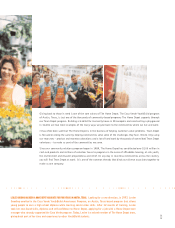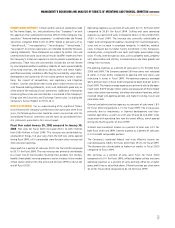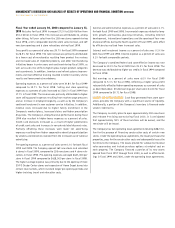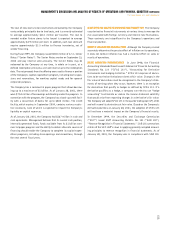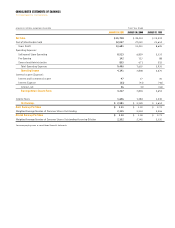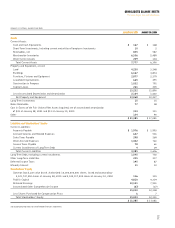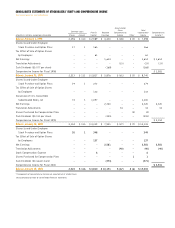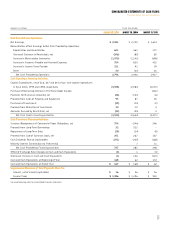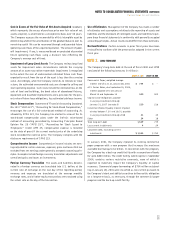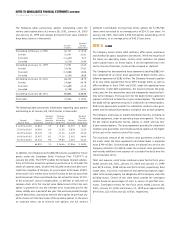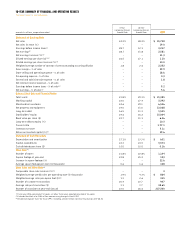Home Depot 2000 Annual Report Download - page 26
Download and view the complete annual report
Please find page 26 of the 2000 Home Depot annual report below. You can navigate through the pages in the report by either clicking on the pages listed below, or by using the keyword search tool below to find specific information within the annual report.
Notes to Consolidated Financial Statements
The Home Depot, Inc. and Subsidiaries
Note 1. Summary of Significant Accounting Policies
The Company operates Home Depot stores, which are full-service,
warehouse-style stores averaging approximately 108,000 square feet
in size. The stores stock approximately 40,000 to 50,000 different
kinds of building materials, home improvement supplies and lawn and
garden products that are sold primarily to do-it-yourselfers, but also
to home improvement contractors, tradespeople and building main-
tenance professionals. In addition, the Company operates EXPO
Design Center stores, which offer products and services primarily
related to design and renovation projects. The Company is currently
testing Villager’s Hardware with four stores, which offer products and
services for home enhancement and smaller project needs in a conven-
ience hardware store format. Additionally, the Company operates one
Home Depot Floor Store, a test store that offers only flooring products
and installation services. At the end of fiscal 2000, the Company was
operating 1,134 stores, including 1,027 Home Depot stores, 26 EXPO
Design Center stores, 4 Villager’s Hardware stores and 1 Home Depot
Floor Store in the United States; 67 Home Depot stores in Canada;
5 Home Depot stores in Chile; 2 Home Depot stores in Argentina; and
2 Home Depot stores in Puerto Rico. Included in the Company’s
Consolidated Balance Sheet at January 28, 2001 were $871 million
of net assets of the Canada, Chile and Argentina operations.
Fiscal Year The Company’s fiscal year is a 52- or 53-week period
ending on the Sunday nearest to January 31. Fiscal years 2000, 1999
and 1998, which ended January 28, 2001, January 30, 2000 and
January 31, 1999, respectively, consisted of 52 weeks.
Basis of Presentation The consolidated financial statements include
the accounts of the Company, its wholly-owned subsidiaries and its
majority-owned partnership. All significant intercompany transactions
have been eliminated in consolidation.
Stockholders’ equity, share and per share amounts for all periods
presented have been adjusted for a three-for-two stock split effected in
the form of a stock dividend on December 30, 1999 and a two-for-one
stock split effected in the form of a stock dividend on July 2, 1998.
Cash Equivalents The Company considers all highly liquid invest-
ments purchased with a maturity of three months or less to be cash
equivalents. The Company’s cash and cash equivalents are carried at
fair market value and consist primarily of commercial paper, money
market funds, U.S. government agency securities and tax-exempt
notes and bonds.
Merchandise Inventories Inventories are stated at the lower of
cost (first-in, first-out) or market, as determined by the retail
inventory method.
Investments The Company’s investments, consisting primarily of
high-grade debt securities, are recorded at fair value and are classi-
fied as available-for-sale.
Income Taxes The Company provides for federal, state and foreign
income taxes currently payable, as well as for those deferred because
of timing differences between reporting income and expenses for
financial statement purposes versus tax purposes. Federal, state and
foreign incentive tax credits are recorded as a reduction of income
taxes. Deferred tax assets and liabilities are recognized for the future
tax consequences attributable to differences between the financial
statement carrying amounts of existing assets and liabilities and their
respective tax bases. Deferred tax assets and liabilities are measured
using enacted tax rates expected to apply to taxable income in the
years in which those temporary differences are expected to be recov-
ered or settled. The effect of a change in tax rates is recognized as
income or expense in the period that includes the enactment date.
The Company and its eligible subsidiaries file a consolidated U.S.
federal income tax return. Non-U.S. subsidiaries, which are con-
solidated for financial reporting, are not eligible to be included in
consolidated U.S. federal income tax returns, and separate provisions
for income taxes have been determined for these entities. The
Company intends to reinvest the unremitted earnings of its non-U.S.
subsidiaries and postpone their remittance indefinitely. Accordingly,
no provision for U.S. income taxes for non-U.S. subsidiaries was
required for any year presented.
Depreciation and Amortization The Company’s buildings, furni-
ture, fixtures and equipment are depreciated using the straight-line
method over the estimated useful lives of the assets. Improvements to
leased premises are amortized using the straight-line method over the
life of the lease or the useful life of the improvement, whichever is
shorter. The Company’s property and equipment is depreciated using
the following estimated useful lives:
Life
Buildings 10 – 45 years
Furniture, fixtures and equipment 5 – 20 years
Leasehold improvements 5 – 30 years
Computer software 3 – 5 years
Advertising Television and radio advertising production costs are
amortized over the fiscal year in which the advertisements first appear.
All media placement costs are expensed in the month the advertisement
appears. Included in current assets are $20.2 million and $24.4 mil-
lion at the end of fiscal 2000 and 1999, respectively, relating to
prepayments of production costs for print and broadcast advertising.



